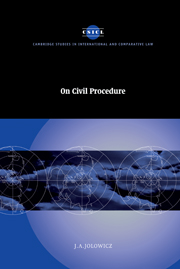Book contents
- Frontmatter
- Contents
- Preface
- List of abbreviations
- Introduction
- I The litigation process
- 1 Civil litigation
- 2 Some twentieth-century developments in Anglo-American civil procedure
- 3 On the nature and purposes of civil procedural law
- 4 The dilemmas of civil litigation
- II Protection of diffuse, fragmented and collective interests
- III Procedural modes
- IV The parties and the judge
- V Recourse against judgments
- VI Procedural reform
- Index
- CAMBRIDGE STUIDES IN INTERNATIONAL AND COMPARATIVE LAW
3 - On the nature and purposes of civil procedural law
from I - The litigation process
Published online by Cambridge University Press: 18 December 2009
- Frontmatter
- Contents
- Preface
- List of abbreviations
- Introduction
- I The litigation process
- 1 Civil litigation
- 2 Some twentieth-century developments in Anglo-American civil procedure
- 3 On the nature and purposes of civil procedural law
- 4 The dilemmas of civil litigation
- II Protection of diffuse, fragmented and collective interests
- III Procedural modes
- IV The parties and the judge
- V Recourse against judgments
- VI Procedural reform
- Index
- CAMBRIDGE STUIDES IN INTERNATIONAL AND COMPARATIVE LAW
Summary
Introduction
In his masterly Hamlyn Lectures, Sir Jack Jacob proposes that 'the true relation between substantive and procedural law should be redefined in terms of the primacy of substantive law and the supremacy of procedure. . . The supremacy of procedure is the practical way of securing the rule of law, for the law is ultimately to be found and applied in the decisions of the courts in actual cases.’ This proposal is of interest for two reasons in particular.
The first of these reasons is, simply, that the proposal should have been made at all. It is true that writers on jurisprudence devote a few pages to the relationship between substantive and procedural law4 and educated English lawyers are aware of Maine's statement that ‘substantive law has at first the look of being gradually secreted in the interstices of procedure’, but in general most people are content to adopt, knowingly or not, Bentham's description of procedure as the course taken for the execution of the laws, and Collins M.R.'s statement that ‘the relation of the rules of practice to the work of justice is intended to be that of handmaid rather than mistress’. Something more is, no doubt, required in certain specific contexts, for example where it is necessary to classify a rule as procedural or not for the purposes of the conflict of laws, or where the validity of a rule of court made under the general rule-making power is in question.
- Type
- Chapter
- Information
- On Civil Procedure , pp. 59 - 80Publisher: Cambridge University PressPrint publication year: 2000



